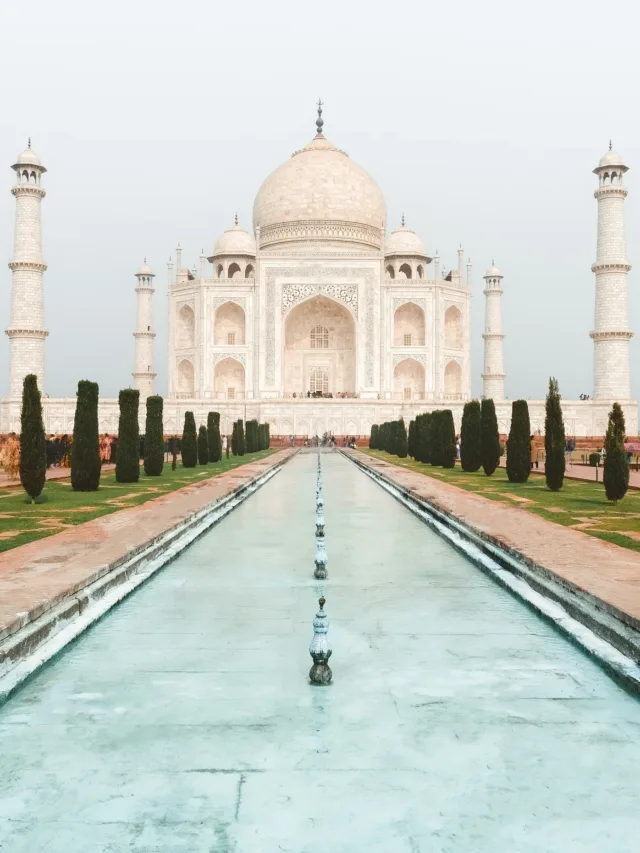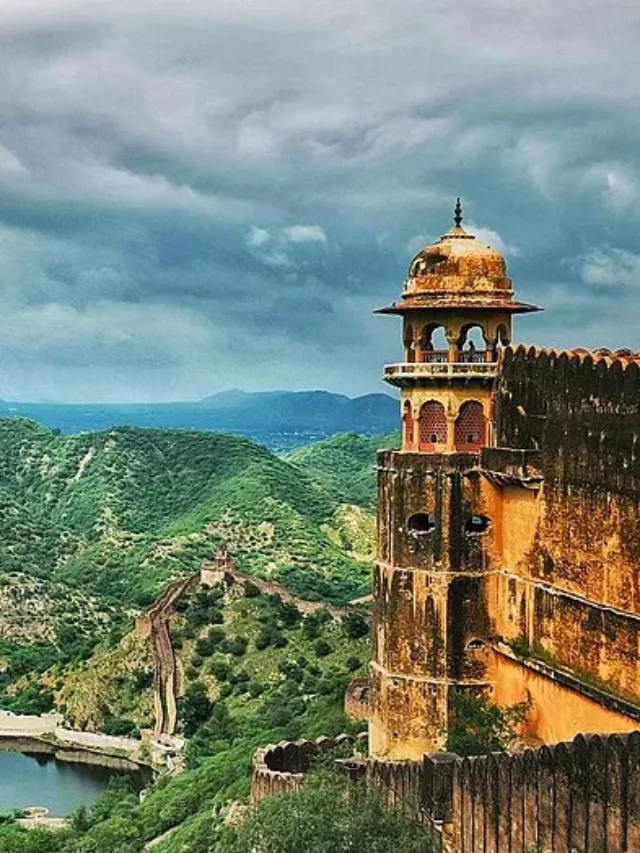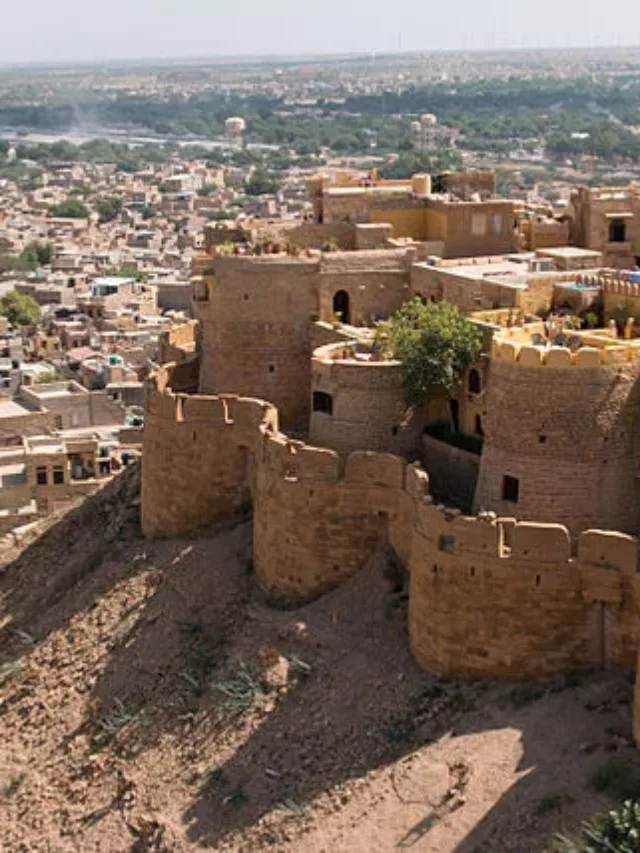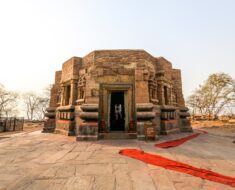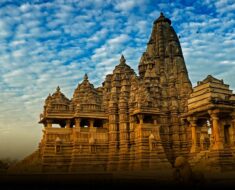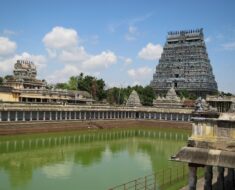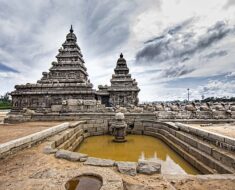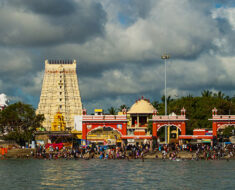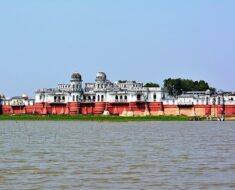India is a country boasting thousands of years of rich history and culture. It is a land that has seen the rise and fall of some of the greatest empires of the world.
Needless to say, its territory is lined by a great number of forts and palaces that have withstood the test of time and bear a living testimony to the architectural brilliance and acumen of ancient Indian builders, artisans and workers.
One such fort that regularly competes at the top for being termed as one of the most majestic forts of India is the Mehrangarh fort at Jodhpur, Rajasthan.
A palace that might have been built by Titans and coloured by the morning sun – Rudyard Kipling
The Mehrangarh Fort truly is a tourist’s delight. It doesn’t matter whether you are a history buff, a lover of traditional culture & cuisine, an admirer of classical architecture and craftsmanship or a simple traveller looking to explore something new, the fort has a little something for everyone.
History of Mehrangarh Fort
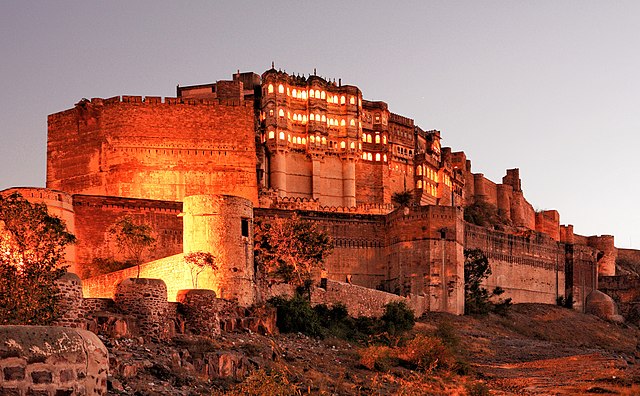
The magnificent Mehrangarh Fort is one of the largest forts in India and a major historical monument in Jodhpur, Rajasthan. The fort was originally constructed by the famous Rajput king, Rao Jodha of the Rathore clan in the 14th century and subsequent major additions were done by Maharaja Jaswant Singh in the 17th century and Maharaja Man Singh in the 18th century.
The actual name of the fort was Mihirgarh which translates to Fort of the Sun or Sun Fort in Sanskrit but the name got diluted over a period of time and owing to the local dialect assumed the current popular title of Mehrangarh.
The fort has been constructed atop a small hill called Bahuchiriya which is close to 120 metres higher in elevation than the surrounding plains. Boasting an area of more than 1200 acres, it is one of the largest forts in India today.
Architecture
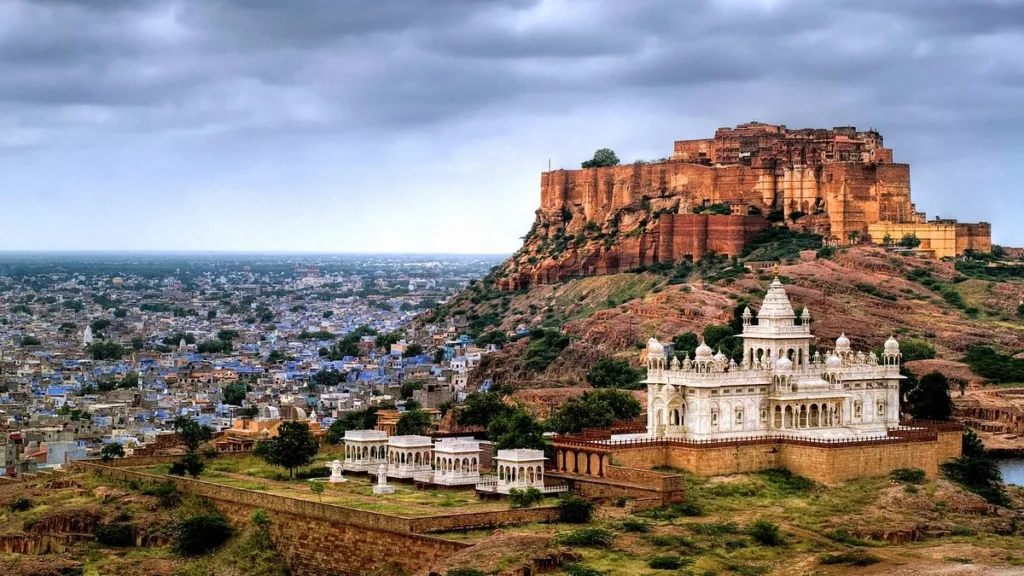
Mehrangarh Fort has very strong walls that are more than 35 metres high and 20 metres wide and have withstood countless attacks and invasions over the years. The boundaries and entrance of the fort are marked with seven commemorative gates popularly termed Pols in the native language such as –
- Jai Pol – Constructed to celebrate a victory over Jaipur & Bikaner in 1806
- Fateh Pol – Constructed to celebrate a victory over the Mughals in 1707
- Gopal Pol – Next gate after the Fateh Pol
- Dedh Kangra Pol – The gate bearing the marks of Cannon ball attacks of the Jaipur army
- Amruti Pol – The gate in-between Dedh Kangra Pol & Loha Pol
- Loha Pol – The last gate that opens into the main fort complex
- Suraj Pol- The innermost gate leading to palaces
The fort complex includes various palaces lined with colossal courtyards showcasing exquisite carvings and intricate architectural designs.
The main palaces include The Moti Mahal, The Phool Mahal, The Sheesh Mahal, The Sileh Khana and Daulat Khana. The mesmerizing craftsmanship and decorations of these palaces are sure to leave any viewer spellbound. It speaks volumes about the artistic prowess of then Rajput artisans of Rajasthan.
Read More: 15 Famous Historical Places in Rajasthan
Palaces in Mehrangarh Fort
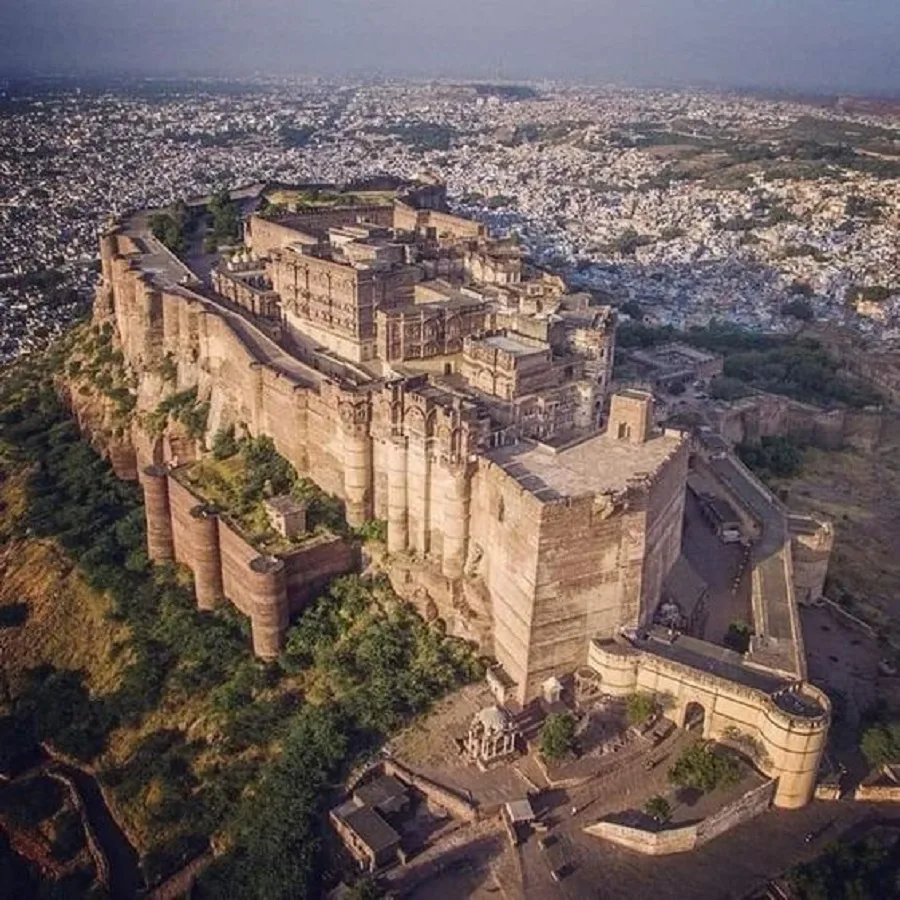
Moti Mahal
The Moti Mahal also known as the Pearl Palace is the largest room of the Mehrangarh Palace adorned with a stunning ceiling made of finely carved stones and decorated with gold leaf, sea shells, mirrors, and coloured window glasses. It was built during the reign of Sawai Raja Sur Singh.
There are five alcoves in this room which lead to hidden balconies, and it is believed that the queens of the Raja sat there and listened to court proceedings, without being seen by other people.
Phool Mahal
The Phool Mahal or the Palace of Flowers was built by Maharaja Abhay Singh as a private chamber for the Maharajas and is embellished with intricate mirror work, colourful glass mosaics, and lavish gold leaf decorations.
Sheesh Mahal

The Sheesh Mahal or the Palace of Mirrors was once part of the private apartment of Maharaja Ajit Singh and used as residential quarters by the Maharajas of Jodhpur. It is intricately decorated with glasswork and the walls have paintings of various scenes from Indian mythology.
Takhat Vilas
The Takhat Vilas also known as Maharaja Takhat Singh’s Chamber was his residence during his reign. He was the last ruler of Jodhpur to reside in the Mehrangarh Fort and was a great patron of the arts, and the room is decorated from ceiling to floor with paintings.
Jhanki Mahal
The palace was built for the queens and princesses of Jodhpur by Maharaja Takhat Singh. It houses a rich collection of royal cradles, decorated with gilt mirrors and figures of fairies, elephants and birds. It had latticed windows so that nobody could see them while they were seeing the outside world.
Read More: Hill Forts of Rajasthan – UNESCO World Heritage Sites
Mehrangarh Museum Galleries
The museum at the Mehrangarh Fort has different galleries showcasing an amazing collection of artefacts clothes, weapons and treasure items of the bygone era.
The main items of attraction include the royal palanquins, the Elephant Howdas (wooden seats fixed atop elephants and lines with gold & silver), Swords of famous rulers like Rao Jodha, Timur and Akbar in addition to numerous other royal swords and guns that have been adorned with precious gemstones like rubies, pearls, emeralds, ivory along with gold and silver platings, Royal clothes, Turbans, Royal Tents, Marvelous Marwari paintings and various handicraft items.
Tourist attractions at Mehrangarh Fort
Chamunda Mata Temple

The fort complex also has a Chamunda Mata temple which was built by the founder Rao Jodha in honour of his Kul Devi or Isht Devi. The Goddess is revered by all the citizens of Jodhpur and the temple remains filled with devotees throughout the year. Rao Jodha brought the idol from Mandore when he founded the fort.
National Geological Monument
The region on which the Mehrangarh Fort has been built has been declared a National Geological Monument by the Geological Survey of India to encourage Geo Tourism in the country.
Rao Jodha Desert Rock Park
A desert rock park in the name of founder Rao Jodha has also been built adjoining the fort complex to restore the ecological properties of the desert region and its vegetation. The park consists of a visitors centre with interpretation facilities, a nursery housing local plants, a small shop and a café.
The fort has folk musicians and dancers performing their classical art forms, restaurants serving local delicacies, exhibitions and bazaars selling a variety of items related to local culture and traditions.
The fort has also been used for the shooting of various Hollywood & Bollywood movies over the years like The Jungle Book, The Dark Knight Rises, Awarapan, Thugs of Hindustan & many more.
Read More: 15 Must-Visit Historical Places in India
Mehrangarh Fort and its Curse
Rao Jodha wanted to construct a fort, but the site was the abode of a local sage and hermit, Cheeria Nath who used to care of the birds in the region and was popularly called Chidiyawale Baba.
Rao Jodha urged him to vacate the hilltop and tried to convince him multiple times but he refused to leave and had to be forcefully ousted from his abode by the King’s men. The enraged sage cursed the king that his capital and fort shall always suffer from water scarcity owing to droughts and thus shall never be prosperous. He got scared by this curse and sought the help of another powerful saint named Karni Mata of Deshnoke.

She requested the hermit to take back his curse. The hermit told her that he could not take back his words but the curse could be nullified if someone from the king’s subjects agreed to get buried alive willfully.
The king searched a lot for someone who would agree to this sacrifice and even promised riches and protection to the family and coming generations of the person agreeing to sacrifice himself. However, he was unable to find someone for a long time.
At last, a nobleman named Raja Ram Meghwal came forward and offered his life for the future of the kingdom. He was buried alive on an auspicious date, the foundation stone of the fort was laid down by Karni Mata in 1459. To honour Rajaram Meghwal, a beautiful sandstone memorial was constructed above his burial site.
It is said that due to her blessings, the fort is still retained by the Rathore clan in all its majesty, unlike other major forts of Rajasthan. Except for Mehrangarh and Bikaner, whose foundations were laid by Karni Mata, other forts were subsequently abandoned by their respective royal clans.
The Sati Handprint Murals

There are legends that a large number of women of the royal families became Sati’s in the fort complex by burning themselves alive on the funeral pyres of their dead husbands over the years. The fort complex still has hand-printed murals of 15 wives of Maharaja Man Singh who died in 1843.
However, It is estimated that even before that hundreds of women have burnt themselves alive in the fort over the years owing to the death of their husbands or fear of dishonourable conduct by victorious rival kings. The locals claim that the spirits of these Sati’s still roam in the complex.
Read More: Top 10 Places to Visit in Jodhpur
Festivals Held in Mehrangarh Fort in Jodhpur

Jodhpur Rajasthan International Folk Festival
Jodhpur Rajasthan International Folk Festival (RIFF) is an international cultural festival that takes place in the Mehrangarh Fort in October and showcases traditional folk dances, music, and artwork from Rajasthan. The festival is timed to coincide with Sharad Purnima, the brightest full moon of the year in north India.
Sacred Spirit Festival
Sacred Spirit Festival celebrates the spiritual journey of music from different cultures and communities. it takes place in February and aims at conserving and keeping alive the Sufi and sacred traditions of India and the world.
Marwar Festival
A two-day festival that celebrates the heroes of Rajasthan. It’s held on the eve of Sharad Poornima on the grounds of the Mehrangarh Fort, Umaid Bhavan Palace, and Mandore The Marwar festival was originally known as the Maand Festival.
The festival is held in the month of Ashwin a Hindu month between September-October. The main attraction of this festival is the folk music centred on the romantic lifestyle of Rajasthan’s rulers.
Best time to visit Mehrangarh Fort
The best time to visit Mehrangarh Fort is during winter, between October to March. During this period the weather remains cool and pleasant and offers you an excellent opportunity to explore the entire fort.
The fort remains open every day from 9 AM–5:30 PM
How to Reach
Jodhpur city is very well connected to the cities of the country by road, air and railways. Mehrangarh Fort is located on the outskirts of Jodhpur city, about 5 km from the city centre and can be reached by below modes of transport
By Air: The nearest airport is Jodhpur Airport, which is about 10 km from the fort. You can take a taxi or a bus from the airport to the fort.
By Train: The nearest railway station is Jodhpur Junction, which is about 6 km from the fort. You can take a taxi, a rickshaw or a bus from the station to the fort.
By Road: The fort is well-connected by road to other cities and towns of Rajasthan and India. You can take a bus, a taxi or a self-drive car from any of these places to the fort.

